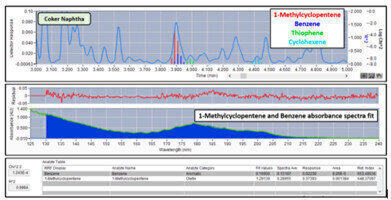-
 Figure 1: Resolution of 1-methylcyclopentene and benzene co-elution within a coker naphtha chromatogram. VUV Analyze™ automates the fitting of analyte spectral profiles with VUV library spectra to provide the identities and relative concentrations of the co-eluting compounds. The fitting agreement between the spectral responses of both compounds with library spectra can be observed by viewing the zero-residual value and spectral agreement in the middle panel, as well as the statistical information in the bottom section of the VUV Analyze™ display. Highlighted peaks show how VUV PIONA+™ customisation can be used to target specific compound classes within a fuel stream sample.
Figure 1: Resolution of 1-methylcyclopentene and benzene co-elution within a coker naphtha chromatogram. VUV Analyze™ automates the fitting of analyte spectral profiles with VUV library spectra to provide the identities and relative concentrations of the co-eluting compounds. The fitting agreement between the spectral responses of both compounds with library spectra can be observed by viewing the zero-residual value and spectral agreement in the middle panel, as well as the statistical information in the bottom section of the VUV Analyze™ display. Highlighted peaks show how VUV PIONA+™ customisation can be used to target specific compound classes within a fuel stream sample.
Analytical Instrumentation
VUV PIONA+™ Extends its Compound Class Capabilities in Fuel Stream Analysis
Oct 19 2017
VUV Analytics, Inc. has recently completed an investigation with coker naphtha samples that indicates VUV PIONA+™ can be used to report compound class analysis of non-conjugated diolefins, conjugated diolefins, cycloolefins, and sulfur compounds. Individual analyte speciation is also possible for many of these compounds. Olefins, especially conjugated diolefins, are known to cause fouling of refinery processes and to negatively impact product quality. VUV PIONA+™ shows the potential for quickly characterizing the most problematic compounds.
VUV PIONA+™ utilises single-column gas chromatography (GC) combined with vacuum ultraviolet (VUV) spectroscopy to provide accurate PIONA hydrocarbon compound speciation up to C6 and bulk compound class characterisation at higher carbon numbers. In addition, specific analytes throughout the chromatogram such as aromatics belonging to the BTEX complex can be targeted for speciation. The product solution combines a VGA-100, the world’s first VUV absorption GC detector, with the automated software analysis of VUV Analyze™.
GC-VUV absorbance data is three dimensional (time, absorbance, wavelength) and specific to compound chemical structure. Chromatographic co-elution events can be addressed using VUV spectral matching and software deconvolution. VUV absorbance spectra are typically highly structured and distinct for individual compounds, yet exhibit the intuitive property of having similar features when measuring related compound classes.
The VUV Analyze™ engine implements equations and fit procedures that result in deconvolution of absorbance spectra that contain contributions from multiple species, is capable of binning and storing response contributions from each deconvolution analysis, and reporting a combined total response at the end of the analysis. The data processing includes a database library of VUV reference spectra, compound class information, density, approximate retention index values, relative response factors for each hydrocarbon class, and relative response factors for individually reported compounds. Compound class or specific compound concentrations can be reported as mass or volume percent.
The customisation of VUV PIONA+™ for fuel streams like coker naphtha samples begins by locating diolefins, cycloolefins, or other compounds of interest in the VUV library that have retention index (RI) values and are associated with a VUV Analyze™ method. These compounds can then be added as “classes” to the VUV Analyze™ Relative Response Factors (RRF) file. In the recent investigation, nine non-conjugated diolefins (C3-C8), sixteen conjugated diolefins (C4-C8), and fourteen cycloolefins (C5-C10) were added to the RRF file to evaluate how they would be identified and quantitated by VUV Analyze™. A response factor value of 0.465 was used for all diolefins and cycloolefins. Compound class analysis was performed on most of these compounds, while key analytes such as 1-methylcyclopentene and cyclohexene were targeted for speciation. A similar setup procedure was applied to characterize thiophene and benzothiophene within the sample. Figure 1 shows the resolution of 1-methylcyclopentene and benzene co-elution within the coker naphtha chromatogram. VUV Analyze™ automates the fitting of analyte spectral profiles with VUV library spectra to provide the identities and relative concentrations of the co-eluting compounds. The fitting agreement between the spectral responses of both compounds with library spectra can be observed by viewing the zero-residual value and spectral agreement in the middle panel, as well as the statistical information in the bottom section of the VUV Analyze™ display. The highlighted peaks show how this VUV PIONA+™ customization can be used to target specific analytes within fuel stream samples and quickly identify critical compound classes.
Digital Edition
PIN 25.1 Feb/March
March 2024
In This Edition Safety - The technology behind the ION Science Tiger XT - Safety with ammonia and LOHCs as hydrogen carriers Analytical Instrumentation - Discussion on new tribology te...
View all digital editions
Events
Apr 22 2024 Hannover, Germany
Apr 22 2024 Marrakech, Morroco
Apr 22 2024 Muscat, Oman
Apr 22 2024 Rotterdam, Netherlands
Apr 23 2024 Singapore

















